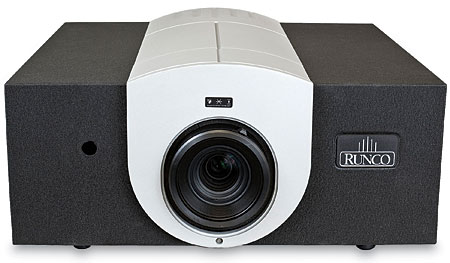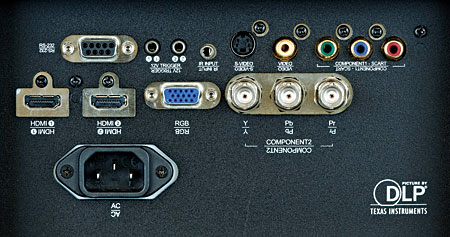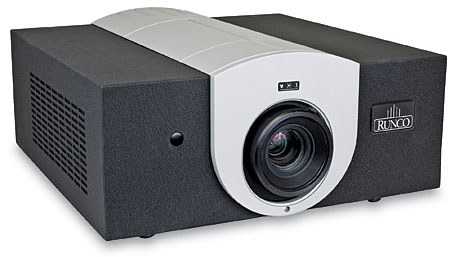Runco Q-750i LED DLP Projector
Solid-State Front Projection

Digital projection is finally digital. Yes, we’ve been looking at projected images made of discrete pixels created by digital imaging chips for the last decade or so. But in one essential aspect, digital projection has remained in the analog domain. The lamps that drive light through these projectors and onto our screens have been 100-percent analog. Even when they’re new, the performance of these lamps can adversely affect color fidelity, gamma, and gray-scale tracking. They also determine the overall light output the projector is capable of. As the lamp ages, virtually all of these critical aspects of performance drift somewhat. In the better designs, the change is mostly benign. But there’s no denying that any lamp-driven projector’s light output drops over time, and multi-hundred-dollar lamp replacements every 2,000 hours or so are a fact of life. Until now.
LED front projection is here, and the Q-750i ($14,995) is Runco’s refined take on this next big thing in front projection. Runco rates the life span of the Q-750i’s LED illumination at 60,000 hours. It also claims that the light output will drop less than 10 percent over that time. Color and gamma tracking should remain in line as well, and look Ma, no lamp changes. Obviously, this convenience and reliability come at a premium in price. In a projector world where superlative sub-$10,000 projectors rule, is there enough performance here to justify that high price tag?
Features
The LED-based full 1080p DLP engine is based on the same PhlatLight solution from Luminus Devices that both the Digital Projection M-Vision (HT, April 2010) and the Vivitek H9080FD (HT, June 2010) LED projectors use. All three of these projectors have more than a little in common, but Runco has worked in some proprietary wrinkles, which I’ll get to in a
bit. None of these otherwise newfangled LED projectors are 3D capable, nor upgradeable to 3D. That’s hardly a criticism since we know so little about the potential for 3D front projection at this point.

While this is a single-chip DLP projector with sequential color, the LEDs cycle the colors rapidly enough that I never detected even a smidgen of color separation (i.e., rainbow) artifacts. While sensitivity to these artifacts varies, it’s difficult for me to believe that even the most sensitive viewers would find them here. As I mentioned, the Q-750i’s rated life on its LED light source is 60,000 hours. If you watch this projector 4 hours a day, that’s about 40 years of use. If you’re one of those scary American statistics and watch this sucker 8 hours per day, you’ll only get about 20 years out of it. As with the other LED projectors we’ve reviewed, duty demands that I admit that we aren’t equipped to verify these longevity claims. As I write this, I’ve had the Q-750i for a good three months, and I’ve put a lot of hours on it. At press time, I could measure no loss of brightness at all and no drift of any kind with any key parameters.
The Q-750i also has a ConstantContrast feature that functions very much like a dynamic iris system. This solution doesn’t open and close an iris dynamically to adjust to the incoming signal’s picture levels. Instead, it alters the LEDs’ current so that it modulates the projector’s light output in accordance with the picture levels of the program material from frame to frame and scene to scene. The result is much the same, and it dramatically improves the projector’s black levels and contrast. Another adjustment, Adaptive Contrast, caused crushing above white and below black, so I left it off. I also avoided SatCo, which engages BrilliantColor processing. Generally, BrilliantColor jerks with color and offers more light output, neither of which was wanting at all in this projector on my 92-inch-wide Stewart StudioTek 130 screen (white, 1.3 gain).

There’s no magic aspect ratio to find for direct pixel mapping. The Q-750i has an Overscan feature that you can set to Off. I used this with the 16:9 aspect ratio, and I didn’t encounter any artifacts. In addition to the standard “front panel” type adjustments (Brightness, Contrast, Sharpness, etc.), there’s a Noise Reduction feature that I never found reason to exploit. In my review of Runco’s wonderful LS-5 DLP projector (HT, May 2010), I praised its straightforward menu operation, and Runco meets that standard again here. You can choose the gamma curve as simply 1.8, 2.0, 2.2, 2.35, or 2.5. How’s that for brilliance through simplicity? No funky names or impenetrable b.s. explanations, just good, hard numbers (and they measure spot on). If you aren’t going the full monty with calibration (tsk-tsk), there are some wonderfully simple and straightforward choices for Color Temperature as well, including the magic 6500K. As our measurements indicate, an ISF calibration will get you even closer, but the Runco’s out-of-box gray-scale performance is very good.
Color Me Blind
The choices and features that pertain to color with the Q-750i could fill a review unto themselves, but that’s referring to volume, not complexity. A reasonably experienced end user will find the menus and features easy to understand and navigate, and they’ll be a breeze for a calibrator or installer. You can accurately adjust the gray scale (at high and low levels, Offset and Gain) in the RGB Adjust submenu.
























































